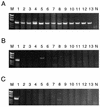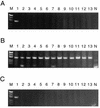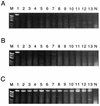Serotype-specific identification of polioviruses by PCR using primers containing mixed-base or deoxyinosine residues at positions of codon degeneracy
- PMID: 9466740
- PMCID: PMC104541
- DOI: 10.1128/JCM.36.2.352-357.1998
Serotype-specific identification of polioviruses by PCR using primers containing mixed-base or deoxyinosine residues at positions of codon degeneracy
Abstract
We have developed a method for determining the serotypes of poliovirus isolates by PCR. Three sets of serotype-specific antisense PCR-initiating primers (primers seroPV1A, seroPV2A, and seroPV3A) were designed to pair with codons of VP1 amino acid sequences that are conserved within but that differ across serotypes. The sense polarity primers (primers seroPV1S, seroPV2S, and seroPV3S) matched codons of more conserved capsid sequences. The primers contain mixed-base and deoxyinosine residues to compensate for the high rate of degeneracy of the targeted codons. The serotypes of all polioviruses tested (48 vaccine-related isolates and 110 diverse wild isolates) were correctly identified by PCR with the serotype-specific primers. None of the genomic sequences of 49 nonpolio enterovirus reference strains were amplified under equivalent reaction conditions with any of the three primer sets. These primers are useful for the rapid screening of poliovirus isolates and for determining the compositions of cultures containing mixtures of poliovirus serotypes.
Figures





Similar articles
-
Group-specific identification of polioviruses by PCR using primers containing mixed-base or deoxyinosine residue at positions of codon degeneracy.J Clin Microbiol. 1996 Dec;34(12):2990-6. doi: 10.1128/jcm.34.12.2990-2996.1996. J Clin Microbiol. 1996. PMID: 8940436 Free PMC article.
-
Molecular Properties of Poliovirus Isolates: Nucleotide Sequence Analysis, Typing by PCR and Real-Time RT-PCR.Methods Mol Biol. 2016;1387:177-212. doi: 10.1007/978-1-4939-3292-4_9. Methods Mol Biol. 2016. PMID: 26983735
-
Poliovirus serotype-specific VP1 sequencing primers.J Virol Methods. 2011 Jun;174(1-2):128-30. doi: 10.1016/j.jviromet.2011.03.020. Epub 2011 Apr 2. J Virol Methods. 2011. PMID: 21440569
-
Genotype-specific RNA probes for direct identification of wild polioviruses by blot hybridization.J Clin Microbiol. 1997 Nov;35(11):2834-40. doi: 10.1128/jcm.35.11.2834-2840.1997. J Clin Microbiol. 1997. PMID: 9350743 Free PMC article.
-
Evolution and polymorphism of poliovirus genomes.Biologicals. 1993 Dec;21(4):379-84. doi: 10.1006/biol.1993.1099. Biologicals. 1993. PMID: 8024754 Review.
Cited by
-
Development of an efficient entire-capsid-coding-region amplification method for direct detection of poliovirus from stool extracts.J Clin Microbiol. 2015 Jan;53(1):73-8. doi: 10.1128/JCM.02384-14. Epub 2014 Oct 22. J Clin Microbiol. 2015. PMID: 25339406 Free PMC article.
-
Proposals for the classification of human rhinovirus species A, B and C into genotypically assigned types.J Gen Virol. 2013 Aug;94(Pt 8):1791-1806. doi: 10.1099/vir.0.053686-0. Epub 2013 May 15. J Gen Virol. 2013. PMID: 23677786 Free PMC article.
-
Development of poliovirus extraction method from stool extracts by using magnetic nanoparticles sensitized with soluble poliovirus receptor.J Clin Microbiol. 2013 Aug;51(8):2717-20. doi: 10.1128/JCM.00499-13. Epub 2013 May 22. J Clin Microbiol. 2013. PMID: 23698530 Free PMC article.
-
Serotype-specific detection of coxsackievirus A16 in clinical specimens by reverse transcription-nested PCR.J Clin Microbiol. 2001 Oct;39(10):3690-2. doi: 10.1128/JCM.39.10.3690-3692.2001. J Clin Microbiol. 2001. PMID: 11574592 Free PMC article.
-
Does Simultaneous Administration of Bivalent (Types 1 and 3) Oral Poliovirus Vaccine and Inactivated Poliovirus Vaccine Induce Mucosal Cross-immunity to Poliovirus Type 2?Clin Infect Dis. 2018 Oct 30;67(suppl_1):S51-S56. doi: 10.1093/cid/ciy604. Clin Infect Dis. 2018. PMID: 30376088 Free PMC article. Clinical Trial.
References
-
- Balanant J, Guillot S, Candréa A, Delpeyroux F, Crainic R. The natural genome variability of poliovirus analyzed by a restriction fragment length polymorphism assay. Virology. 1991;184:645–654. - PubMed
-
- Birmingham, M. E., R. W. Linkins, B. P. Hull, and H. F. Hull. 1997. Poliomyelitis surveillance: the compass for eradication. J. Infect. Dis. 175(Suppl. 1):S146–S150. - PubMed
-
- Bodian D, Morgan I M, Howe H A. Differentiation of types of poliomyelitis viruses. Am J Hyg. 1949;49:234–245. - PubMed
MeSH terms
Substances
LinkOut - more resources
Full Text Sources
Other Literature Sources

